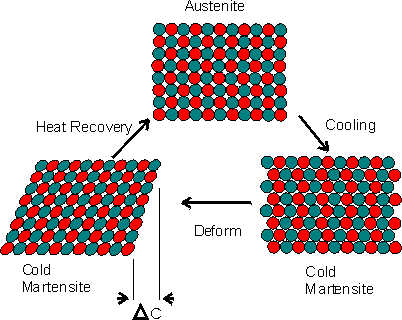
How it Works
The properties of nitinol depend upon its dynamic heat sensitive crystalline structure. When Nitinol is deformed in the martensite phase, the crystalline structure is not damaged. Instead the crystal structure transforms moving in a singular crystalline direction. When heated the material returns to its "remembered" lest stress austenite structure.
In normal metals, deformations causes the delocations of the molecular structure into new crystal positions. There is no "memory" in the crystal of where the atoms were before they moved.
The physical movement of Nitinol is attributed to internal molecular restructuring. And because movement is generated on a molecular level, it is quite strong. Nitinol alloy has three distinct temperature phases:
Martensitic Phase.
Low temperature phase. The crystal structure is aligned and cubic. The alloy may be bent or formed easily. Deformation pressure required is 10,000 to 20,000 psi. Bending deforms the crystalline structure of the alloy producing internal stress.
Austenite Phase.
Temperature is above transition temperature. The movement generated in this phase is cause by the crystalline structure returning to its non-stress state (cubic). The exact transition temperature varies depending upon the exact composition of the nitinol alloy; commercial alloys usually have transitional temperatures between 70C to 130C (158 to 266F). The yield strength with which the material tries to return to its original shape is considerable; 35,000 to 70,000 psi.
Annealing Phase.
High temperature phase. The alloy will reorient its (cubic) crystalline structure to "remember" its present shape. The annealing phase for the nitinol wire we are working with is approximately 540C.
Physical Properties:
Tensile Strength --- 200,000 psi
Melting Point --- 1,250C (2,282 F)
Resistance --- 1.25 ohms per inch (.006 wire)
Corrosion Resistant
A quick overview of Nitinol phases are: nitinol at room temperature is in its martensitic phase. When the alloy is bent, crystalline structure deforms, creating internal stress. Heating the alloy above its transition temperature (Austenite phase), the crystalline structure tries to relieve any stress in its crystalline structure by returning to its original "remembered" shape. This creates the thermal movement of the SMA.
Of course, if the alloy hasn't any been deformed or stressed in the martensite phase, the crystalline structure changes still occur, but doesn't result in any net movement.

